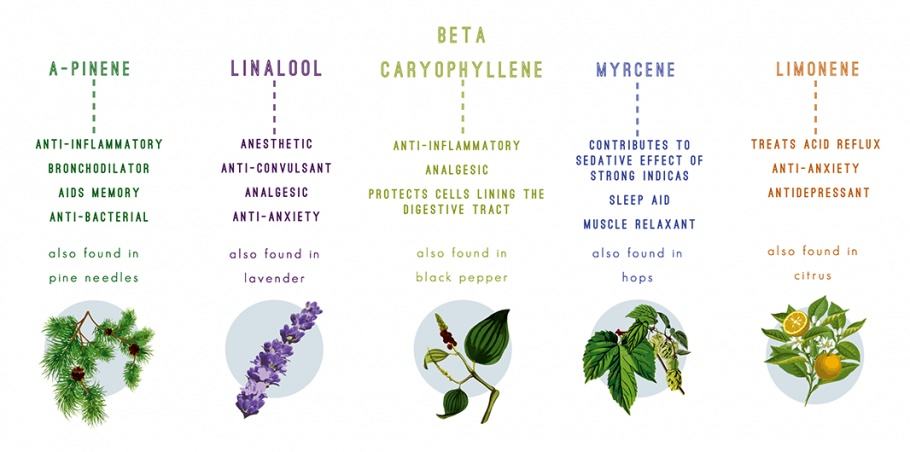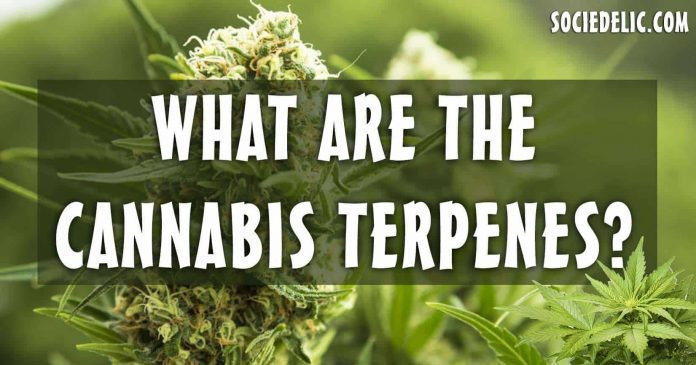What Are Cannabis Terpenes And What Do They Do?
Scientists are still working on their research in order to understand all the ways Terpenes have been helping humanity for thousand years. When we get to know the role of Terpenes and their connection with other Cannabis elements, we’ll be able to have a better view. Of course, Terpenes can be found in other plants, not only Cannabis. In fact, because of them many plants have their “natural” aroma and flavor. Different levels of Terpenes are also responsible for different smells and tastes of marijuana. These chemical compounds make each and every cannabis strain special. Moreover, Terpenes also have a lot of medical effects. They tend to interact with other components of the plant in a way that boosts the therapeutic benefits of cannabinoids as the THC and CBD. This is called as the “entourage effect”.
 Here are the basic 5 terpenes, out of 120 found in cannabis:
Here are the basic 5 terpenes, out of 120 found in cannabis:
Myrcene: Tropical fruit taste is most recognizable characteristic of this terpene, which can be found in mango and cannabis plants. Level of myrcene decides whether some strain is indica or sativa. Together with antiseptic ability and its cancer-fighting characteristics, myrcene relaxes muscles and has anti-inflammatory effects. Myrcene has very specific medical properties, because it allows for many other chemicals to reach the brain more quickly. For example, when it comes to THC, myrcene boosts its effect. Also, myrcene allows bigger psychoactive effect, by increasing CB1 receptor’s saturation level.
Myrcene can be found in Pure Kush, Skunk #1 and White Widow.
Limonene: Responsible for fresh lemon aroma (found in many fruits as well), limonene also improves immune system, acts as antiseptic, helps solve gastrointestinal problems, and lowers stress/anxiety level. Since a couple of decades ago, limonene has been used in citrus cleaner. It’s almost non-toxic, and people usually don’t react badly to it. Also, limonene helps lift up the mood and make people more talkative. Another beneficial property of limonene is that it helps absorbing other terpenes, and its protein-permeating ability makes it great anti-fungal substance.
It can be found in Lemon Haze and OG Kush.
Pinene: It has the smell of a pine forest, and its freshness is going to make you feel more connected to the earth. However, it can be found not only in pines, but in any conifer. As it has bronchodilating properties, it’s very helpful with asthma. Two isomers of pinene are α-pinene( has anti-cancer properties) and β-pinene. Both of them are very important parts of pine resin. In fact, α-pinene is terpenoid that you’re going to most likely find in the nature. Despite most commonly found in conifers, pinene can also be found in many non-conifer plants, so it’s practically everywhere (balsamic resin, pine woods, some citrus fruits etc.). Also, α-pinene and β-pinene make for the main component of wood turpentine. Pinene reacts with other chemicals, making various other terpenes and compounds. . Additionally, is an effective antiseptic, and it has anti-inflammatory, expectorant and bronchodilator effects.
Pinene can be found in Jack Herer, Blue Dream and Trainwreck.
Beta Carophyllene: Beta Carophyllene’s aroma can be found in clove or pepper. It solves insomnia, and has analgesic, anti-inflammatory and anti-oxidant effects. It is a sesquiterpene which can be found in various plants, from Thai basils to lavender. Specifically, it is used in chewing gum (combined with citrus flavorings or some other mixtures). According to the research, Beta Carophyllene binds to the CB2 receptor, and it is CB2 agonist. Not only that, but it has been qualified as a non-psychoactive CB2 receptor ligand, and macrociclyc anti-inflammatory cannabinoid. Another study reports that the way Beta Carophyllene works with other cannabinoids could be very effective in chronic pain treatment.
Beta Carophyllene can be found in Bubba Kush, OG Kush and Hash plant.
Linalool: Limalool has candy-like aroma, and it helps in pain, seizure and inflammation relieving. It can often be found in the Lamiaceae plant and herb family, as well as in Lauraceae plant family (laurels, cinnamon, rosewood etc.) and Rutaceae family (citrus plants), birch trees and some plants from tropical or boreal climate zones. Some fungi produce limalool too, despite not being plants. The Environmental Protection Agency allows using limalool as a flavor agent, scent or pesticide. Bath and body products commonly list limalool as beta linalool, linalyl alcohol, linaloyl oxide, p-linalool or alloocimenol. Fruit flie, fleas and cockroaches react badly to the limalool vapors. Anti-inflammatory effect allows limalool to help those with Alzheimer’s Disease, by restoring cognitive and emotional functions. Also, together with reduce lung inflammation, it has anti-acne and anty-depressive effects.
Linalool can be found in Amnesia Haze, Lavender and LA confidential.
